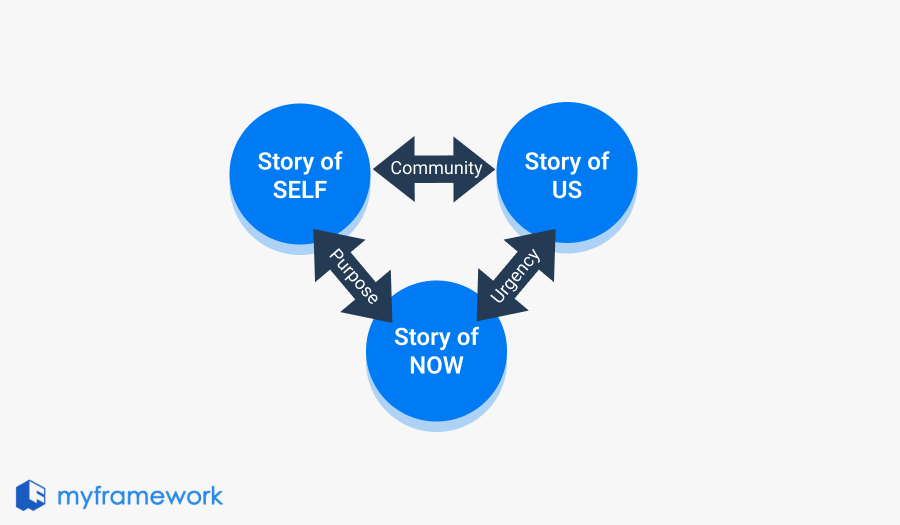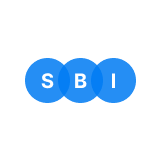The Self/Us/Now framework, developed by Marshall Ganz, is a powerful storytelling and leadership tool used to inspire action, particularly in community organizing, advocacy, and leadership contexts.
Ganz, a Harvard professor and longtime activist, designed this framework to help individuals and groups connect personal stories to collective action.
Key Components of the Framework

Story of Self
Tell who you are, the value you hold, and why you care.
This part is about sharing your personal journey, values, and experiences. It focuses on what motivates you and why you care about the cause or issue at hand.
The “Story of Self” allows you to build credibility and authenticity with your audience by showing vulnerability and passion.
The Self establishes an emotional connection and authenticity.
Story of Us
Create a sense of unity with the audience by explaining shared values and goals. It answers the question: Who are we together, and what do we stand for?
This is about creating a collective identity by connecting your personal story to the experiences and values of the group you are addressing.
The “Story of Us” emphasizes shared values, experiences, and challenges. It encourages the audience to see themselves as part of a larger community or movement.
The Us strengthens that connection by creating a shared identity and purpose.
Story of Now
This component focuses on the urgency of the current moment. It calls the audience to action by outlining the immediate challenges or opportunities and framing why it’s critical to act now.
The “Story of Now” pushes people to move from reflection to action. It answers the question: What is at stake, and why must we act now?
The Now moves the audience toward action by emphasizing the urgency of the moment.
Applications
The Self/Us/Now framework is widely used in:
- Political campaigns: To motivate and mobilize supporters.
- Advocacy movements: To inspire collective action on social justice, environmental, or human rights issues.
- Leadership development: To help leaders craft compelling narratives that drive change.
Now let’s see how each scenario works.
Political Campaign
Scenario: A candidate running for local office wants to mobilize voters around the issue of affordable housing.
- Story of Self: The candidate shares a personal experience of growing up in a family that struggled with housing insecurity, explaining how this shaped their passion for making housing more affordable for everyone.
- Story of Us: The candidate connects their experience with the struggles of local residents, emphasizing shared values like community, stability, and dignity. They highlight how many in the community face similar challenges with rising rents and lack of affordable homes.
- Story of Now: The candidate frames the current election as a pivotal moment, with policies on affordable housing being decided by those elected. They stress the need for immediate action and urge voters to support their campaign to drive change now.
Example:
I grew up watching my parents work hard, yet still struggle to afford a place for us to live. I know firsthand how housing insecurity feels. But I’m not the only one. Our community is filled with families who face the same worry, wondering whether they’ll be able to make rent next month. Right now, we have an opportunity to elect leaders who can finally tackle this issue head-on, but we need to act now. Let’s work together to make affordable housing a reality.
Unlock all frameworks and templates
Unlock exclusive thinking frameworks and practice templates.
Become a member to access all premium content to elevate your thinking!
Environmental Advocacy
Scenario: An environmental activist is leading a campaign to reduce plastic waste in their city.
- Story of Self: The activist shares how a personal experience witnessing plastic pollution on a local beach inspired them to act.
- Story of Us: They connect this personal story with the shared responsibility of the city’s residents to keep their environment clean, highlighting how everyone is affected by plastic waste.
- Story of Now: The activist stresses the current environmental crisis, particularly how plastic waste is escalating. They call for residents to sign a petition for stricter regulations on plastic use.
Example:
Last year, I stood on our beautiful beach and saw it littered with plastic waste. It was shocking to see how much damage we’re doing to the environment. But I know I’m not alone in caring about our city and the planet. Together, we value clean air, water, and a healthy future for our children. But we can’t wait any longer. Right now, our city council is considering a law to reduce plastic use, and we need to show our support. Sign this petition today to help make a real difference.
Nonprofit Fundraising
Scenario: A nonprofit organization wants to raise funds for providing clean drinking water in rural areas.
- Story of Self: The executive director shares a personal story of visiting a rural village and witnessing the impact of dirty water on children’s health.
- Story of Us: They relate the personal experience to the organization’s broader mission of providing clean water to communities in need, emphasizing shared values of compassion and responsibility.
- Story of Now: The executive director highlights an urgent need for funding to complete a water project and calls for immediate donations, explaining how every dollar will make a direct impact.
Example:
During my visit to a small village in Kenya, I met children whose lives were changed by access to clean water. It’s heartbreaking to see families suffer because of something as basic as water. But what touched me even more was how much we, as a community, can do to help. Together, we’ve already built wells that serve thousands, but there are still villages waiting. Right now, we need your support to finish our next project. Every dollar you give today can bring clean water to a child tomorrow.


